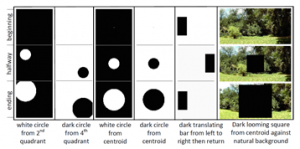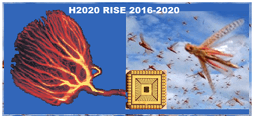University of Lincoln researcher Mu Hua has completed his Master’s degree and is applying for a PhD position to continue his exploration on the bio-inspired collision perception neural networks.

STEP2DYNA researcher Mu Hua from the University of Lincoln has completed a two-month secondment at project partner Guangzhou University in China. During his secondment, Mu progressed his work on the establishment of a novel neural network. This network is based on the recently discovered, and peculiarly placed, visual projection neurons called lobula plate/lobula columnar type 2 (LPLC2). These neurons are found in the fruit fly, Drosophila, and are most sensitive to the looming motion patterns originating from the centre of the receptive field (see figure 1), and have not been numerically described in detail.

Inspired by peculiarly placed directionally selective neurons called lobula plate tangential cells (LPTCs) and their pre-synaptic neurons, the establishment of novel neural network firstly estimates motions, along with four cardinal directions within the parallel ON/OFF channels, and then delivers the gathered to the LPTCs for channel information integration. Eventually, the LPLC2 neuropile accepts the conveyed information and generates spikes accordingly.
To verify the feasibility of the proposed method, several stimuli are used (see figure 2).

From experimental results collected, the proposed neural network manages to spike to the looming pattern from radial motion opponency (see fig 3).


However, in this research, lateral inhibition has been slightly considered to make a difference to the final outputs. The neuroscientific evidence shows the initial size significantly impacts the peak of the membrane potential of LPLC2 neuropile. It is assumed that the way lateral inhibition works shall be a key to further simulate the characterizations of the pre-found looming sensitive neuron, which shall be carefully considered in the further works.
Mu states “I have enjoyed and appreciated the opportunity to carry out a secondment under the STEP2DYNA project. Thanks to the EU funding this project, I have been able to take advantage of this secondment to meet with leading researchers at Guangzhou University, share ideas with them, and make use of their laboratory facilities.”
